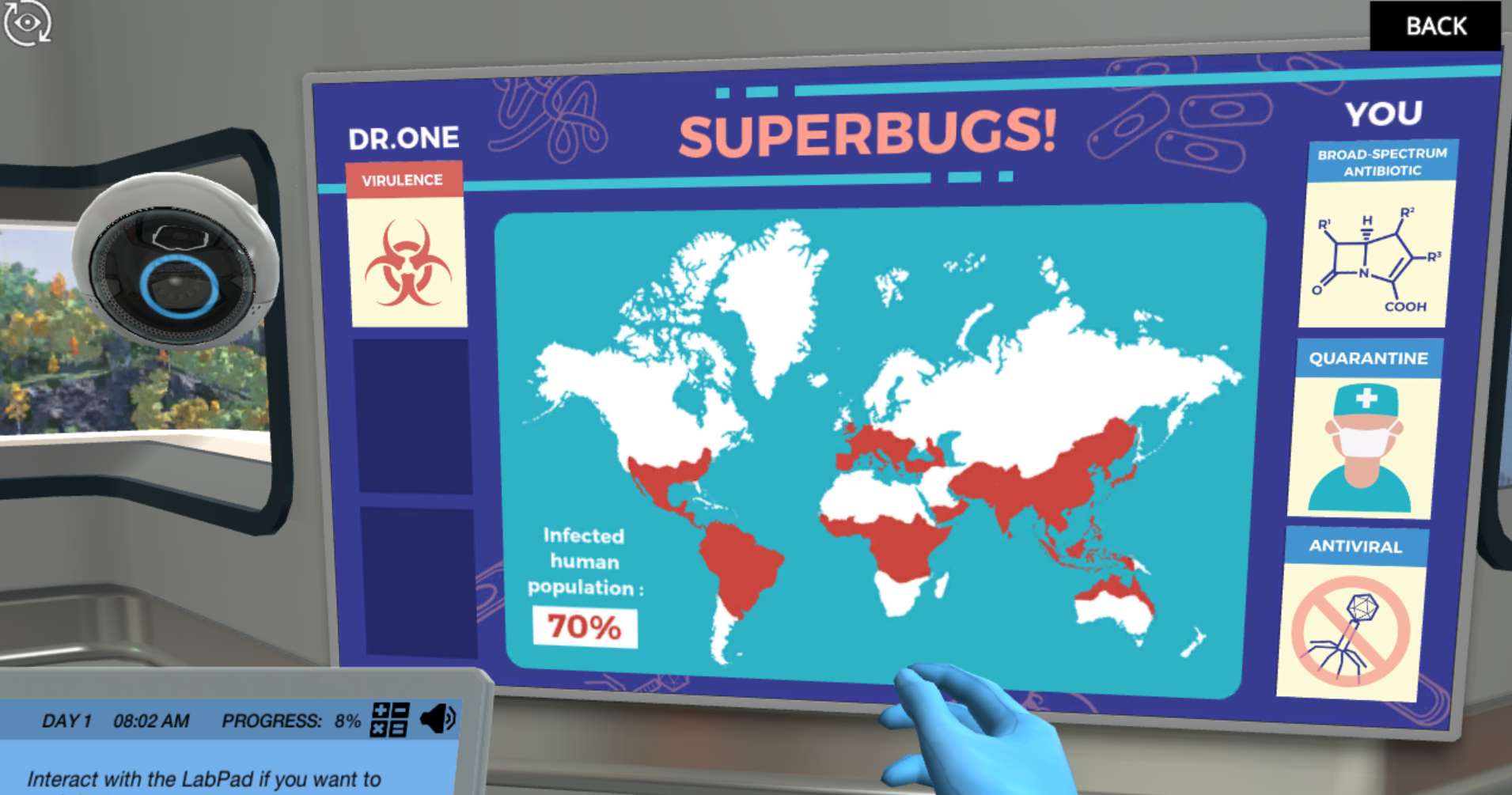Heading 1
Heading 2
Heading 3
Heading 4
Heading 5
Heading 6
Lorem ipsum dolor sit amet, consectetur adipiscing elit, sed do eiusmod tempor incididunt ut labore et dolore magna aliqua. Ut enim ad minim veniam, quis nostrud exercitation ullamco laboris nisi ut aliquip ex ea commodo consequat. Duis aute irure dolor in reprehenderit in voluptate velit esse cillum dolore eu fugiat nulla pariatur.
Block quote
Ordered list
- Item 1
- Item 2
- Item 3
Unordered list
- Item A
- Item B
- Item C
Bold text
Emphasis
Superscript
Subscript
About This Simulation
Prevent Dr. One from wiping out humanity! Complete a number of learning games to understand the three ways of genetic transfer in bacteria, transduction, transformation, and conjugation, and use your learnings to prevent the rise of superbugs.
Learning Objectives
- Distinguish vertical gene transfer from horizontal gene transfer
- Understand the concept of genetic variability and survivability in bacteria
- Describe the concept of horizontal gene transfer
- Identify genetic elements and cell machinery required for DNA transfer
- Outline the main events that occur during conjugation, transformation, and transduction
- Discuss the outcome and barrier of genetic transfer in bacteria
About This Simulation
Lab Techniques
- Bacteria morphology examination
- MEGA-Plate setup
- Basic agar plate setup
Related Standards
- No direct alignment
- No direct alignment
- Biology 3.5 Genetic modification and biotechnology
Learn More About This Simulation
Humanity is in grave danger due to powerful antibiotics becoming ineffective in the treatment of multi-resistant bacteria, also called superbugs. In this simulation, you will learn about the powerful abilities of these superbug bacteria. Your task is to find out how they acquire the foreign DNA that allows them to become superbugs.
Beat Dr. One in the board game ”Superbugs!”
In this simulation, you will try to beat Dr. One in a board game. This board game isn’t like other board games, however. Here, you will learn about the spread of bacterial infection and try to prevent a global pandemic! Dr. One is the enemy, trying to wipe out the human race, and it’s your task to save them! While playing this game, you will learn the key concepts of horizontal gene transfer in bacteria.
Learn the basics of bacterial genetics
First, you will learn about mutation and genetic elements of bacteria, which include chromosomes and plasmids. You will recreate the famous Microbial Evolution and Growth Arena (MEGA) plate developed by Harvard University and Technion-Israel Institute of Technology to highlight the inheritance of antibiotic resistance across many generations of bacteria. You have the freedom to decide where to grow your culture and how to set the antibiotic concentration levels. In the process, you will strengthen your understanding of the concept of mutation and its relation to the development of antibiotic resistance in bacteria.
Perform bacteria culture experiments
The spread of antibiotic resistance is not only a result of inherited random genetic mutations. By analyzing a patient’s sample with a resistant strain of Acinetobacter baumanii, you will be able to identify three methods of horizontal gene transfer that the bacteria can use to acquire foreign DNA. You will set up agar plates with your sample and controls, and complete a series of small learning games to understand the mechanisms and concepts behind conjugation, transformation and transduction.
Dive into the microbe realm
After completing the experiments and learning activities, you will take a virtual leap into the microscopic world. With bacteria, plasmids, and bacteriophages floating around you, your task is to find out which type of horizontal gene transfer will occur, based on your observation on the bacteria’s characteristics and surrounding environment.
Will you be able to grasp all the learning concepts behind the acquisition of antibiotic resistance? And will you be able to prevent Dr. One from winning the board game and wiping out the human race? We hope so!
Boost STEM Pass Rates
Boost Learning with Fun
75% of students show high engagement and improved grades with Labster
Discover Simulations That Match Your Syllabus
Easily bolster your learning objectives with relevant, interactive content
Place Students in the Shoes of Real Scientists
Practice a lab procedure or visualize theory through narrative-driven scenarios


For Science Programs Providing a Learning Advantage
FAQs
Find answers to frequently asked questions.
Heading 1
Heading 2
Heading 3
Heading 4
Heading 5
Heading 6
Lorem ipsum dolor sit amet, consectetur adipiscing elit, sed do eiusmod tempor incididunt ut labore et dolore magna aliqua. Ut enim ad minim veniam, quis nostrud exercitation ullamco laboris nisi ut aliquip ex ea commodo consequat. Duis aute irure dolor in reprehenderit in voluptate velit esse cillum dolore eu fugiat nulla pariatur.
Block quote
Ordered list
- Item 1
- Item 2
- Item 3
Unordered list
- Item A
- Item B
- Item C
Bold text
Emphasis
Superscript
Subscript
Labster can be integrated within a school's LMS (Learning Management System), and students can access it like any other assignment in their LMS. If your Institution does not choose an LMS integration, students will log in to Labster's Course Manager once they have an account created. Your institution will decide the access method during the sales process.
Labster is available for purchase by instructors, faculty, and administrators at education institutions. Purchasing our starter package, Labster Explorer, can be done using a credit card if you are located in the USA, Canada, or Mexico. If you are outside of North America or are choosing a higher plan, please speak with a Labster sales representative. Compare plans.
Labster simulations are created by real scientists and designed with unparalleled interactivity. Unlike point and click competitors, Labster simulations immerse students and encourage mastery through active learning.
Labster supports a wide range of courses at the high school and university level across fields in biology, chemistry and physics. Some simulations mimic lab procedures with high fidelity to train foundational skills, while others are meant to bring theory to life through interactive scenarios.


















